0423 Peter Grille, Kuroshawa. 主角介紹 Criterion Collection 中日本電影選 反思Wim Wenders最近電影 “Perfect Days,” ... “komorebi”(means the play of sunlight ..)..."漫談"Donald Keene 譯/著的日本文學" 40 ;哥倫比亞大學的「唐納德・基恩中心」等同事 Peter Grilli 在日本 (代々木八幡宮) 神木憶交往 Shares Memories of Keene 。.鹿橋 《人子 》六《本木物語》..... 1972/1974/....... Parables of Sun Light By Rudolf Arnheim
反思Wim Wenders最近電影 “Perfect Days,” ... “komorebi”(means the play of sunlight ..)..."漫談"Donald Keene 譯/著的日本文學" 40 ;哥倫比亞大學的「唐納德・基恩中心」等同事 Peter Grilli 在日本 (代々木八幡宮) 神木憶交往 Shares Memories of Keene 。.鹿橋 《人子 》六《本木物語》..... 1972/1974/....... Parables of Sun Light By Rudolf Arnheim
https://www.facebook.com/hanching.chung/videos/994513875576760
But there’s something else here. It seems that Wenders’s eye, like Hirayama’s, snagged on the shadows. The canopies of trees are omnipresent in the film, seeping into Hirayama’s dreams at night, which Wenders renders in hazy black and white.
There’s a word in Japanese that transliterates to “komorebi” and refers to a phenomenon for which there is no single word in English: the quality of light as it filters through foliage. Hirayama’s life and mind are full of shadows, despite the sunlight he keeps reaching for. The light of komorebi is not full brightness — it is glistening, ever-changing, full of variation. Hirayama loves this, and he photographs it because the constant capture of what other people miss — the subtle shifts in the canopy every single day — are for him another indication of the trees’ vitality.[Tokyo] Yoyogi Hachimangu Shrine (代々木八幡宮)
但這裡還有別的事情。看起來,文德斯的眼睛和平山的眼睛一樣,抓住了陰影。樹冠在片中無所不在,滲透進平山夜晚的夢境,文德斯用朦朧的黑白色來呈現。
日語中有一個詞音譯為“komorebi”,指的是一種英語中沒有單字描述的現象:光線穿過樹葉時的品質。儘管平山不斷追求陽光,但他的生活和心靈卻充滿陰影。枯萎光的光芒並不是無比明亮,而是閃閃發光、千變萬化、充滿變化。平山很喜歡這種感覺,他拍攝這些照片是因為不斷捕捉別人所忽略的景象——樹冠每天發生的細微變化——對他來說,這是樹木生命力的另一種體現。 [東京] 代代木八幡宮 (代々木八幡宮)
彼得‧格里利 (PETER GRILLI) 是波士頓日本協會會長,也是著名的日本歷史與文化專家。他童年的大部分時間都在日本長大,並獲得了哈佛大學東亞研究學士和碩士學位。在東京,他也曾就讀早稻田大學和東京大學。
1971 年至 1975 年,他擔任東京 Weatherhill 的高級編輯;1975 年至 1987 年,他擔任紐約日本協會電影、教育和表演藝術項目主任。後來,他領導了PBS的日本計畫(1986-89年),隨後在紐約經營一家獨立顧問公司,專門從事與日本相關的媒體、企業傳播和文化交流。 1996年至2000年,他擔任哥倫比亞大學唐納德·基恩日本文化中心主任。
2000年,他被邀請擔任波士頓日本協會會長,該協會是美國40多個日美協會中歷史最悠久的協會。
2003年,格里利先生被日本政府授予三級聖物章,以表彰其長期為日美文化交流做出的貢獻。 2009年,他獲得了重光衛獎。
格里利先生為國際雜誌和報紙撰寫了大量有關日本的文章,包括《紐約時報》、《華爾街日報》、《GEO》、《亞洲雜誌》、《日本時報》和《日本季刊》。他是《FURO:日本浴場》和《電影中的日本:日本紀錄片和戲劇電影綜合目錄》等書籍的作者。作為一名紀錄片製片人,他編寫或共同製作了以下電影:「神道教:日本的自然、神與人」(1978 年);《夢窗:日本花園的倒影》(1992) 「武光徹:電影音樂」(1994);以及《黑澤明》(2001 年)。身為日本古典和當代文化活動的製作人,他負責美國主要的歌舞伎、能劇和文樂巡演,以及日本的許多其他電影、音樂和戲劇節目。
PETER GRILLI is President of The Japan Society of Boston and a well-known specialist on Japanese history and culture. Raised in Japan for most of his childhood, he received BA and MA degrees in East Asian Studies from Harvard University. In Tokyo, he also studied at Waseda University and Tokyo University.
He worked as Senior Editor at Weatherhill in Tokyo from 1971-75 and Director of the Film, Education, and Performing Arts Programs at the Japan Society of New York, 1975-87. He later headed The Japan Project of PBS (1986-89), and subsequently operated an independent consulting office in New York, specializing on Japan-related media, corporate communications, and cultural exchange. From 1996-2000, he was Director of the Donald Keene Center of Japanese Culture at Columbia University.
In 2000, he was invited to become President of the Japan Society of Boston, the oldest of more than 40 Japan-America Societies in the U,S,.
In 2003, Mr. Grilli was awarded the Third Class Order of the Sacred Treasure by the Government of Japan in recognition of long service in cultural exchanges between Japan and the U.S. In 2009, he received the Shigemitsu Mamoru Award.
Mr. Grilli has written extensively on Japan for international magazines and newspapers, including The New York Times, Wall Street Journal, GEO, Asia Magazine, The Japan Times, and The Japan Quarterly. He is author of the books "FURO: The Japanese Bath" and "JAPAN IN FILM: A Comprehensive Catalogue of Documentary and Theatrical Films on Japan." As a documentary filmmaker he wrote or co-produced the films: "SHINTO: Nature, Gods and Man in Japan" (1978); "DREAM WINDOW: Reflections on the Japanese Garden" (1992); "TORU TAKEMITSU: Music for the Movies" (1994); and "KUROSAWA" (2001). As producer of Japanese classical and contemporary cultural events, he has been responsible for major U.S.tours of Kabuki, Noh, and Bunraku tours, as well as many other film, musical and theatrical programs from Japan.
【影片】《渡邊直美赴哥倫比亞大學演講》
由美國哥倫比亞大學舉辦、介紹日本文化的活動中,首次將「搞笑文化」納入主題。以紐約為活動據點的日本藝人渡邊直美,在活動中以英語演講,引起現場觀眾哄堂大笑。
哥倫比亞大學的「唐納德・基恩中心」,從30多年前開始舉辦各式活動來介紹日本文化,至目前為止曾邀請過知名的作家和藝術家。
#搞笑文化 #日本文化 #渡邊直美 #紐約 #哥倫比亞大學
👇更多訊息
https://www3.nhk.or.jp/nhkworld/zt/news/,
Peter Grilli, Long-time Friend of Donald Keene Devoted to Cultural Exchange between Japan, U.S. Shares Memories of Keene

Peter Grilli during an interview at his childhood playground, Yoyogi Hachimangu shrine in Shibuya Ward, Tokyo, on April 10
11:35 JST, April 20, 2024
Peter Grilli, a writer, documentary filmmaker, and former President of the Japan Society of Boston, was a good friend of Donald Keene’s for over half a century. He has made many significant contributions to cultural exchanges between Japan and the U.S., including various events he conducted as the Director of the Donald Keene Center at Columbia University in the 1990s. While Grilli was visiting Japan for the first time in five and a half years, I interviewed him on a day that cherry blossoms were at full peak about his memories of Keene and the current state of cultural exchange between the two countries.
Our meeting place was Yoyogi Hachimangu shrine in Shibuya Ward, Tokyo. Grilli had suggested that we meet at the shrine, and there was a reason for that. The grounds of the shrine appear as an important location in Wim Wenders recent film “Perfect Days,” and when Grilli saw the film he instantly recognized the location as a favorite spot from his childhood in Tokyo. The 81-year-old Grilli had lived nearby for two years beginning in 1948, when he was five years old, and the shrine was his beloved playground. Grilli, who calls this trip a sentimental journey, wanted to return to the place of his childhood memories.
As we climbed the stone steps leading up to the main shrine, he said, “In the film, there is a scene where the lead actor, Koji Yakusho, sitting on a bench here at Hachimangu shrine, looks up at the trees and says, ‘These trees are my friends.’ When I saw that, I thought, ‘That’s exactly what I used to think.’ The same trees are still here, and they are still my friends.” The house nearby where he had lived with his family is now the Embassy of Vietnam.
Reaching Ordinary People
“I think I first met Donald Keene in Japan, but I don’t remember exactly. I was never Donald’s student,” Grilli began to speak, sitting on the same bench where Yakusho sat in the movie. Starting from 1995, when Grilli became Director of the Donald Keene Center at Columbia University, the two met almost daily in New York while Keene was there for six months every year. “We talked about ordinary things, not so much about Japanese literature. We talked mostly about music, opera, cooking and occasionally a little bit about literature, too.”
The Center had been founded in 1986 by Barbara Ruch, a former student of Keene’s and herself a professor at Columbia University, with the aim of extending understanding of Japanese culture beyond the academic world to the broader American public.
During his five years as Director of the Donald Keene Center, Grilli presented many concerts, films, symposia and public performances. One example was a big international symposium about Chikamatsu Monzaemon (1653-1725), the great Edo period (1603-1867) playwright, inviting well-known Japanese professors, filmmakers, actors and theater professionals who had specialized in Chikamatsu’s plays. “Donald loved that kind of thing,” Grilli recalled. “Early in his own academic career, he had studied and translated many of Chikamatsu’s plays, and throughout his life he had a special love for the bunraku puppet theater. He was unquestionably a great professor and translator and he did superb academic work as a scholar. But he was also deeply interested in how ordinary people perceived Japan. His books, and research are of course essential studies of Japan, but he also wanted ordinary people to read them and come to understand and appreciate Japanese culture. In that way, I think Donald was quite unusual.”
Grilli felt a similar sense of responsibility to the general public. That is why Grilli was determined to share his own love of Japanese films, music, kabuki, bunraku, and other popular Japanese arts with American audiences. Earlier in his own career as a program director at the Japan Society of New York, Grilli had produced major presentations of Japanese arts to large public audiences.
Broader Cultural Relationships
“Donald was a giant!” Grilli recalled of Keene’s many accomplishments. “He did so much. Many of his books were written for ordinary people, in a style that is fairly easy to read. In that sense, his role was very extremely important.”
Grilli commented that Japanese studies in the U.S. are now in their third or fourth generation. Keene was a leader of the first postwar generation, together with Edwin O. Reischauer, Edward Seidensticker and a few others. They were the pioneers, followed by a second generation that learned from them, and now it is time for a new generation of writers and scholars, to carry forward their work.
The pioneering Keene wrote the following message in a 2013 tribute book honoring the achievements of Peter Grilli, his friend and colleague.
“It doesn’t seem possible, but I think I have known Peter for fifty years. The difficulty in recognizing this fact comes from his not having changed either in appearance or enthusiasms. His constancy shows in his love for the classics of music: even works he has heard countless times, he still hears with excitement. His unfailing taste enables him also to discover and enjoy what is of genuine worth in the new.”
Grilli moved to Boston in 2000 and became President of the Japan Society of Boston, where he has devoted himself to cultural exchange between Japan and Boston. The Japan Society of Boston is the oldest Japan Society in the U.S., celebrating its 120th anniversary this year. John Manjiro (Nakahama Manjiro), the famous Japanese fisherman who, in 1841, was rescued by an American whaling ship after being lost at sea in the Pacific Ocean, later arrived in the U.S., and lived near Boston, Massachusetts, where the Japan Society of Boston is located. The Museum of Fine Arts, Boston and the Peabody Essex Museum of Salem also have renowned collections of Japanese fine arts as well as the everyday items of Japanese commoners during the Edo and Meiji eras (1868-1912), collected by Edward Morse, who discovered the well-known Omori Kaizuka Shell Mounds archaeological site.
During my interview with Peter Grilli, I felt his warm personality and passion for Japanese culture. Similarly, Donald Keene wrote this message in the tribute book.
“Peter is a great collector, not so much of recordings of music as of people. His warmth and concern for others makes friends even of strangers. I know no one who has as many friends in Japan and that must be true of Boston as well.”
As we sat talking quietly at Yoyogi Hachimangu shrine, we noticed a visitor embracing a large sacred tree in the vicinity of the shrine, across the way from our bench. She seemed to be praying to the tree, and Grilli gazed at her intently.
“It’s interesting,” he said. “How traditional cultural values seem to be preserved in such places.” And then, he continued: “The opportunities for cultural exchanges are much greater now between Japan and other countries. For example, just consider the JET program, where young people come and teach in local Japanese communities spending two or three years. They go back to their native countries, where some of them — remembering their friendships in Japan — continue to work in Japan-related businesses or in Japanese studies. That’s a vital new kind of relationship which, I am sure, will become increasingly important in the future.”
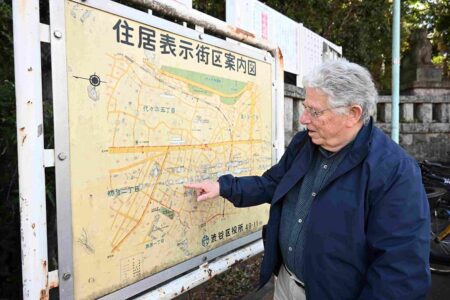
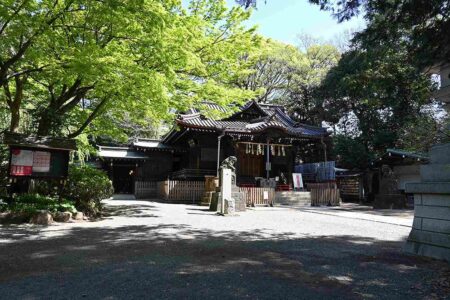



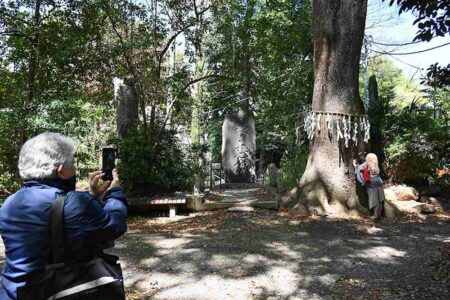
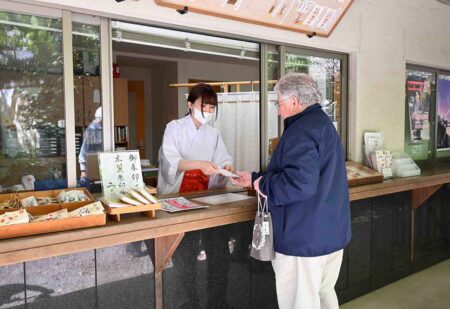

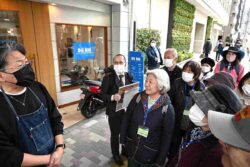
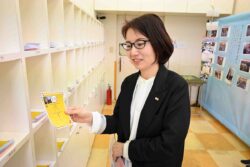


沒有留言:
張貼留言